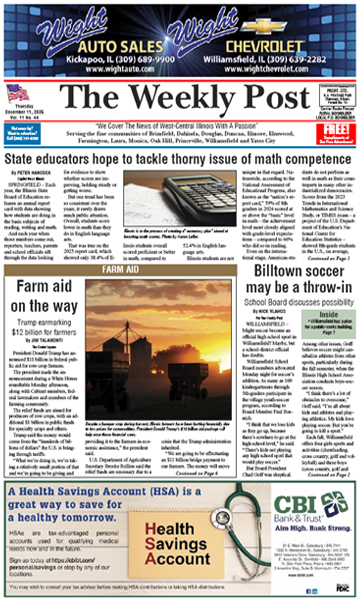By KATIE ZELECHOWSKI
Illinois Farm Bureau
Most drivers know the feeling of running late for an important meeting or event and how tempting it can be to speed up to shave a bit of time off of the commute.
But as fall weather rolls into Illinois this season, so does farm equipment used during harvest. Sparing five extra minutes to safely navigate around these slow-moving vehicles helps ensure everyone on the road gets home at the end of the day.
As the daughter of a truck driver, high school ag teacher Kaity Spangler knows the dangers that come with operating farm equipment but knows not all of her students do.
“My biggest thing is making sure our students know that their classmates – the people they see in the hallway – are the people they are sharing the road with,” said Spangler, who teaches at Macomb High School.
Putting names and faces to farm equipment operators in the community makes students more responsible and respectful drivers, she said.
“I tell my students ‘Blaine is driving the tractor, Duncan is in the combine’ to really drive home that their classmates are the ones in those slow-moving vehicles,” Spangler said.
The focus on farm safety will go well beyond Spangler’s classroom this month during National Farm Safety and Healthy Week.
This year, the theme of the week, recognized Sept. 19-25, is “Farm Safety Yields Results.” Daily topics include tractor and rural roadway safety, youth in agriculture safety and overall farmer health and safety.
Illinois State Police (ISP) Sgt. Tracy Lillard has seen the devastating consequences of vehicle accidents while on the job. As the manager for ISP’s social media pages, she shares her experiences to educate motorists about roadway safety. During harvest, her advocacy efforts ramp up to focus on keeping drivers safe around large, often slow-moving equipment including tractors and semis.
“The trucking community is something that I really hold close to my heart,” Lillard said. “My husband is a police officer as well (and) both of our parents were farmers. We really see the need for people that are driving this machinery, and then also the grain haulers (that are going) back and forth, to be safe.”
Lillard has seen many rear-end crashes result from motorists who follow farm equipment and semitrailers too closely. She encourages drivers to leave more room for others.
One of the most frequent questions Lillard gets is why farmers can’t use different routes when moving equipment. She said it comes down to the size of the vehicle, road conditions and whether or not they have safer, better options.
“These farmers are out on the road just like everybody else and they have the right to be there,” she said.
Road safety is not limited to adhering to speed limits. It’s also about drivers showing courtesy to one another, staying alert when behind the wheel and practicing caution when navigating new situations – all of which should be done year-round.
Rodney Knittel, Illinois Farm Bureau assistant director of transportation and infrastructure, said the health and safety of farm families impacts more than those who work on the farm.
“Every single person relies on agriculture for food and the transportation industry to deliver the goods they need,” Knittel said.
“Driving behind agriculture equipment may add on five, 10 or 15 minutes to your commute,” he said. “But at the end of the day, what’s most important is that every family gets home safely.”
This story was distributed through a cooperative project between Illinois Farm Bureau and the Illinois Press Association. For more farming news, visit FarmWeekNow.com.







